#jedi order
Text
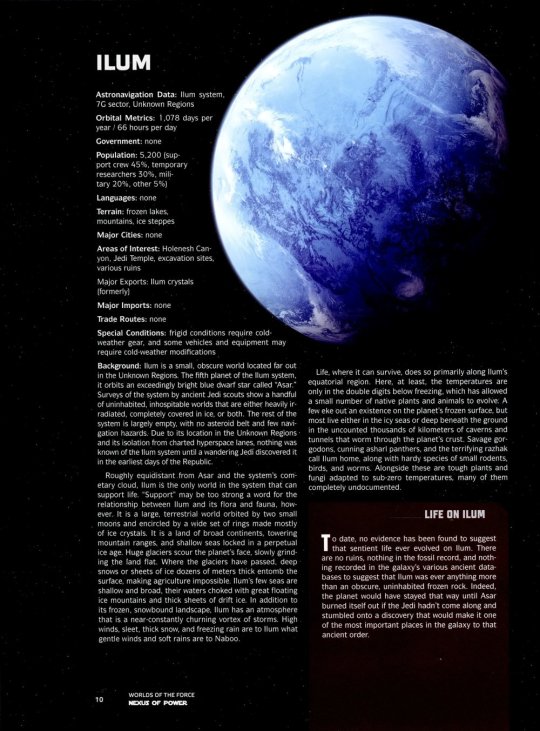
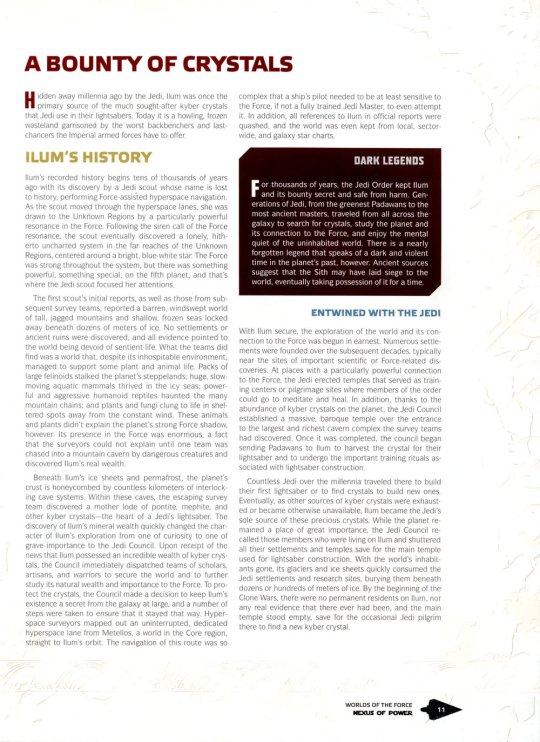
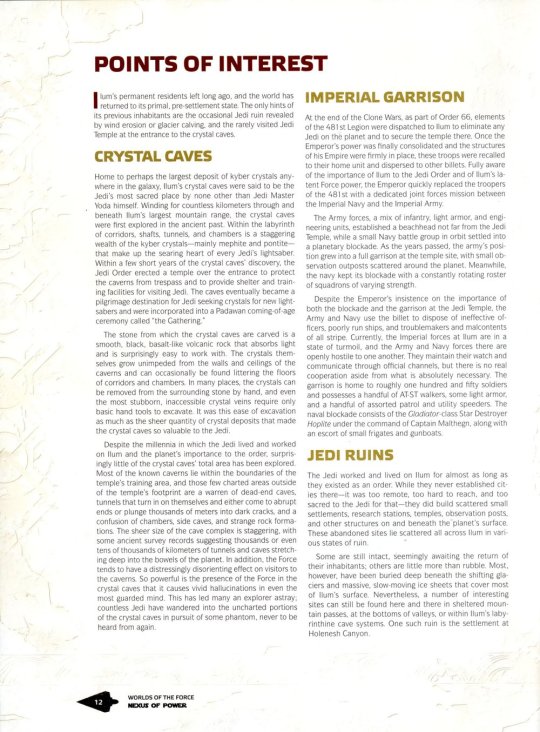



PLANET: ILUM
Astronavigation Data: Ilum system, 7G sector, Unkonwn Regions
Orbital Metrics: 1,078 days per year/66 hours per day
Goverment: None
Population: 5,200 (support crew 45%, temporary researchers 30%, military 20%, other 5%)
Languages: None
Terrain: Frozen lakes, mountains, ice steppes
Major Cities: None
Areas of Interest: Holenesh Canyon, Jedi Temple, excavation sites, various ruins
Major Exports: Ilum crystals
[Source: Star Wars - Force and Destiny - Nexus of Power - Force Worlds]
BACKGROUND:
Ilum is a small, obscure world located far out in the Unknown Regions. The fifth planet of the Ilum system, it orbits an exceedingly bright blue dwarf star called “Asar.” Surveys of the system by ancient Jedi scouts show a handful of uninhabited, inhospitable worlds that are either heavily irradiated, completely covered in ice, or both. The rest of the system is largely empty, with no asteroid belt and few navigation hazards. Due to its location in the Unknown Regions and its isolation from charted hyperspace lanes, nothing was known of the Ilum system until a wandering Jedi discovered it in the earliest days of the Republic.
Roughly equidistant from Asar and the system’s cometary cloud, Ilum is the only world in the system that can support life. “Support” may be too strong a word for the relationship between Ilum and its flora and fauna, however. It is a large, terrestrial world orbited by two small moons and encircled by a wide set of rings made mostly of ice crystals. It is a land of broad continents, towering mountain ranges, and shallow seas locked in a perpetual ice age. Huge glaciers scour the planet’s face, slowly grinding the land flat. Where the glaciers have passed, deep snows or sheets of ice dozens of meters thick entomb the surface, making agriculture impossible. Ilum's few seas are shallow and broad, their waters choked with great floating ice mountains and thick sheets of drift ice. In addition to its frozen, snowbound landscape, Ilum has an atmosphere that is a near-constantly churning vortex of storms. High winds, sleet, thick snow, and freezing rain are to Ilum what gentle winds and soft rains are to Naboo.
Life, where it can survive, does so primarily along Ilum's equatorial region. Here, at least, the temperatures are only in the double digits below freezing, which has allowed a small number of native plants and animals to evolve. A few eke out an existence on the planet’s frozen surface, but most live either in the icy seas or deep beneath the ground in the uncounted thousands of kilometers of caverns and tunnels that worm through the planet’s crust. Savage gorgodons, cunning asharl panthers, and the terrifying razhak call Ilum home, along with hardy species of small rodents, birds, and worms. Alongside these are tough plants and fungi adapted to sub-zero temperatures, many of them completely undocumented.
LIFE ON ILUM:
To date, no evidence has been found to suggest that sentient life ever evolved on Ilum. There are no ruins, nothing in the fossil record, and nothing recorded in the galaxy’s various ancient databases to suggest that Ilum was ever anything more than an obscure, uninhabited frozen rock. Indeed, the planet would have stayed that way until Asar burned itself out if the Jedi hadn’t come along and stumbled onto a discovery that would make it one of the most important places in the galaxy to that ancient order.
ILUM'S HISTORY:
Ilum's recorded history begins tens of thousands of years ago with its discovery by a Jedi scout whose name is lost to history, performing Force-assisted hyperspace navigation. As the scout moved through the hyperspace lanes, she was drawn to the Unknown Regions by a particularly powerful resonance in the Force. Following the siren call of the Force resonance, the scout eventually discovered a lonely, hitherto uncharted system in the far reaches of the Unknown Regions, centered around a bright, blue-white star. The Force was strong throughout the system, but there was something powerful, something special, on the fifth planet, and that's where the Jedi scout focused her attentions.
The first scout's initial reports, as well as those from sub sequent survey teams, reported a barren, windswept world of tall, jagged mountains and shallow, frozen seas locked away beneath dozens of meters of ice. No settlements or ancient ruins were discovered, and all evidence pointed to the world being devoid of sentient life. What the teams did find was a world that, despite its inhospitable environment, managed to support some plant and animal life. Packs of large felinoids stalked the planet's steppelands; huge, slow moving aquatic mammals thrived in the icy seas; powerful and aggressive humanoid reptiles haunted the many mountain chains; and plants and fungi clung to life in sheltered spots away from the constant wind. These animals and plants didn't explain the planet's strong Force shadow, however. Its presence in the Force was enormous, a fact that the surveyors could not explain until one team was chased into a mountain cavern by dangerous creatures and discovered Ilum's real wealth.
Beneath Ilum's ice sheets and permafrost, the planet's crust is honeycombed by countless kilometers of interlocking cave systems. Within these caves, the escaping survey team discovered a motherlode of pontite, mephite, and other kyber crystals—the heart of a Jedi's lightsaber. The discovery of Ilum's mineral wealth quickly changed the char acter of Ilum's exploration from one of curiosity to one of grave importance to the Jedi Council. Upon receipt of the news that Ilum possessed an incredible wealth of kyber crystals, the Council immediately dispatched teams of scholars, artisans, and warriors to secure the world and to further study its natural wealth and importance to the Force. To pro tect the crystals, the Council made a decision to keep Ilum's existence a secret from the galaxy at large, and a number of steps were taken to ensure that it stayed that way. Hyperspace surveyors mapped out an uninterrupted, dedicated hyperspace lane from Metellos, a world in the Core region, straight to Ilum's orbit. The navigation of this route was so complex that a ship’s pilot needed to be at least sensitive to the Force, if not a fully trained Jedi Master, to even attempt it. In addition, all references to Ilum in official reports were quashed, and the world was even kept from local, sector wide, and galaxy star charts.
DARK LEGENDS:
For thousands of years, the Jedi Order kept Ilum and its bounty secret and safe from harm. Generations of Jedi, from the greenest Padawans to the most ancient masters, traveled from all across the galaxy to search for crystals, study the planet and its connection to the Force, and enjoy the mental quiet of the uninhabited world. There is a nearly forgotten legend that speaks of a dark and violent time in the planet’s past, however. Ancient sources suggest that the Sith may have laid siege to the world, eventually taking possession of it for a time.
ENTWINED WITH THE JEDI:
With Ilum secure, the exploration of the world and its connection to the Force was begun in earnest. Numerous settle ments were founded over the subsequent decades, typically near the sites of important scientific or Force-related discoveries. At places with a particularly powerful connection to the Force, the Jedi erected temples that served as training centers or pilgrimage sites where members of the order could go to meditate and heal. In addition, thanks to the abundance of kyber crystals on the planet, the Jedi Council established a massive, baroque temple over the entrance to the largest and richest cavern complex the survey teams had discovered. Once it was completed, the council began sending Padawans to Ilum to harvest the crystal for their lightsaber and to undergo the important training rituals associated with lightsaber construction.
Countless Jedi over the millennia traveled there to build their first lightsaber or to find crystals to build new ones. Eventually, as other sources of kyber crystals were exhaust ed or became otherwise unavailable, Ilum became the Jedi’s sole source of these precious crystals. While the planet remained a place of great importance, the Jedi Council recalled those members who were living on Ilum and shuttered all their settlements and temples save for the main temple used for lightsaber construction. With the world’s inhabitants gone, its glaciers and ice sheets quickly consumed the Jedi settlements and research sites, burying them beneath dozens or hundreds of meters of ice. By the beginning of the Clone Wars, there were no permanent residents on Ilum, nor any real evidence that there ever had been, and the main temple stood empty, save for the occasional Jedi pilgrim there to find a new kyber crystal.
CRYSTAL CAVES:
Home to perhaps the largest deposit of kyber crystals any where in the galaxy, Ilum’s crystal caves were said to be the Jedi’s most sacred place by none other than Jedi Master Yoda himself. Winding for countless kilometers through and beneath Ilum’s largest mountain range, the crystal caves were first explored in the ancient past. Within the labyrinth of corridors, shafts, tunnels, and chambers is a staggering wealth of the kyber crystals—mainly mephite and pontite— that make up the searing heart of every Jedi’s lightsaber. Within a few short years of the crystal caves’ discovery, the Jedi Order erected a temple over the entrance to protect the caverns from trespass and to provide shelter and training facilities for visiting Jedi. The caves eventually became a pilgrimage destination for Jedi seeking crystals for new lightsabers and were incorporated into a Padawan coming-of-age ceremony called “the Gathering.”
The stone from which the crystal caves are carved is a smooth, black, basalt-like volcanic rock that absorbs light and is surprisingly easy to work with. The crystals themselves grow unimpeded from the walls and ceilings of the caverns and can occasionally be found littering the floors of corridors and chambers. In many places, the crystals can be removed from the surrounding stone by hand, and even the most stubborn, inaccessible crystal veins require only basic hand tools to excavate. It was this ease of excavation as much as the sheer quantity of crystal deposits that made the crystal caves so valuable to the Jedi.
Despite the millennia in which the Jedi lived and worked on Ilum and the planet’s importance to the order, surprisingly little of the crystal caves’ total area has been explored. Most of the known caverns lie within the boundaries of the temple’s training area, and those few charted areas outside of the temple’s footprint are a warren of dead-end caves, tunnels that turn in on themselves and either come to abrupt ends or plunge thousands of meters into dark cracks, and a confusion of chambers, side caves, and strange rock formations. The sheer size of the cave complex is staggering, with some ancient survey records suggesting thousands or even tens of thousands of kilometers of tunnels and caves stretching deep into the bowels of the planet. In addition, the Force tends to have a distressingly disorienting effect on visitors to the caverns. So powerful is the presence of the Force in the crystal caves that it causes vivid hallucinations in even the most guarded mind. This has led many an explorer astray; countless Jedi have wandered into the uncharted portions of the crystal caves in pursuit of some phantom, never to be heard from again.
JEDI RUINS:
The Jedi worked and lived on Ilum for almost as long as they existed as an order. While they never established cities there—it was too remote, too hard to reach, and too sacred to the Jedi for that—they did build scattered small settlements, research stations, temples, observation posts, and other structures on and beneath the planet’s surface. These abandoned sites lie scattered all across Ilum in various states of ruin.
Some are still intact, seemingly awaiting the return of their inhabitants; others are little more than rubble. Most, however, have been buried deep beneath the shifting glaciers and massive, slow-moving ice sheets that cover most of Ilum’s surface. Nevertheless, a number of interesting sites can still be found here and there in sheltered mountain passes, at the bottoms of valleys, or within Ilum’s labyrinthine cave systems. One such ruin is the settlement at Holenesh Canyon.
HOLENESH CANYON:
Located some five hundred kilometers from the main Jedi Temple at the mouth of the crystal caves, Holenesh Canyon is a deep, sheer-sided cleft in the planet’s surface over a kilometer deep that runs for roughly ten kilometers through one of Ilum's vast mountain ranges. The settlement, once home to around one hundred sentients, was built near the canyon’s end in the shadow of the mountain range’s highest peaks. It was established millennia ago to study a strange fluctuation in the Force that seemed to occur only once every few hundred years. Named for the Jedi who first recorded the anomaly, this small, isolated outpost stood for centuries before being destroyed in an avalanche triggered by a massive groundquake coinciding with the reappearance of the Force anomaly. Many of the settlement’s inhabitants were killed as they slept, but some managed to escape with little more than the clothes on their backs or what they could grab in their flight. Further seismic disturbances, combined with freak storms, prevented the mounting of a proper rescue mission, and by the time the Jedi were able to return to the canyon, the settlement was completely covered in snow and countless tons of fallen stone.
In the millennia since the destruction of the settlement, parts of it have been exposed through erosion and seismic activity. While the buildings are barely recognizable as such, their contents were surprisingly well preserved. Thanks to the remoteness of the ruined settlement and the difficulty of reaching it, precious little has been removed from the site. Anyone possessing the skills and courage to excavate the site might unearth any number of ancient Jedi relics.
CREATURES AND CHALLENGES:
Ilum's climate is exceptionally harsh. Its land and most of its surface water are locked away beneath glaciers and permanent sheets of ice. Temperatures, even in what are usually considered temperate or tropical zones on other worlds, can sink to dozens of degrees below freezing. These temperatures are typically accompanied by howling gales and blizzards full of driving snow and ice shards. Few creatures, and even fewer plants, live on Ilum. To survive in these brutal conditions, Ilum's creatures and plants are both extremely hardy and extremely dangerous.
ASHARL PANTHER [RIVAL]:
Asharl panthers are one of the more common predators on Ilum. They are large, aggressive, territorial felines that make their homes in Ilum's high northern and southern latitudes. Adult asharl panthers average between two and three meters long and stand roughly one meter high at the shoulder. Their four powerful legs end in two-toed feet equipped with nonretractable claws. The creatures’ bodies are covered in dense, smooth fur in shades of white, gray, and blue that holds their body heat in to protect them from the cold and driving wind. They have broad, earless heads with pronounced brow ridges, and their faces are remark ably expressive, with short, blunt snouts and golden eyes. The most noticeable feature is a pair of long, tentacle-like sensory organs that grow from their shoulders. Asharl panthers live in small family groups and typically hunt in pairs or in groups of four.
BLISMAL [MINION]:
Blismal are small, furry, inoffensive rodents who live in the tunnels and caverns deep beneath Ilum's surface. About the size of a grown human’s hand, blismal have four legs; sharp featured faces with small black eyes, round ears, and long snouts; and short, hairless tails. Their bodies are covered in thick, luxurious, silvery fur that keeps them warm and sheds water and dirt. They feed mostly on cave fungus and insects, and they are happy to be left alone in the dark to live out their lives.
Like the harmless snowfeathers, which live on the surface, blismal have few natural predators. This is largely due to their speed and cautious natures, although they do have a frighteningly effective defense mechanism. When frightened, blismal make a shrill, painful, and sustained shrieking noise to ward off attackers and call for assistance from other blismal. When three or more blismal join in, they create a howl loud enough to shatter crystals and cause cave-ins, an ability that Jedi experienced firsthand long ago. The Jedi attributed this ability to the blismal’s close connection to the Force, and were able to counter the effects of the shrieking by manipulating the Force around the creatures. In doing so, Jedi exploring Ilum's cavern system were able to capture blismal, which turned out to be relatively easy to domesticate.
GORGODON [RIVAL]:
Gorgodons are, perhaps, the most famous creatures to live on frozen Ilum. They are massive, non-sentient, thick-skinned reptilian creatures with long, powerful arms, short legs, and an axe-shaped head. A thick, shaggy coat of dark gray fur covers them from their shoulders to their feet, leaving only their head, which is a sickly orange color, bare to the elements. Gorgodons are incredibly strong and can with stand almost any punishment. It is said that they can even shrug off blaster bolts. They are a dangerous combination of dumb, aggressive, and brutal, and are one of the few animals that attack for no good reason. When the Jedi first arrived on Ilum, the gorgodons were the creatures that gave them the most trouble. Throughout the Jedi Order, the name of this creature was used in threats and curses, such as “thick as a gorgodon” or “as angry as a gorgodon’s mother.”
RAZHAK [NEMESIS]:
Among the most fearsome predators on Ilum, these massive creatures are as agile as they are deadly. Averaging around eight meters in length, razhak-are armored, segmented, wormlike creatures that propel themselves using rippling muscle ridges. Their bodies are broad and flat, covered with thick, chitinous plates in shades of white and blue. While they have no apparent eyes, their heads are topped with long, segmented antennae that serve as sensory organs. Their huge mouths feature multiple rows of serrated teeth.
Aggressive and solitary, razhak live in the endless tunnel systems beneath Ilum's surface. They are deceptively fast and, when they attack, they rear up like a serpent and at tempt to swallow prey whole. Anything they can’t eat in one bite they tear into pieces by grasping it in their mouth and shaking it violently. In addition to possessing great speed and a savage demeanor, razhak also can generate intense heat strong enough to rapidly melt solid ice and cause serious burns to exposed flesh. This ability allows them to tunnel through ice as though it were soft sand. Razhak usually build their nests inside of ice walls or densely packed snow, typically leaving the nest only to eat or mate.
Thankfully, while they are terrifying to behold and extremely dangerous, razhak are also easily distracted and creatures of minimal intelligence. Keeping this in mind, a clever opponent can easily outflank them, lead them into traps, or make them lose interest in attacking altogether.
SNOWFEATHER [MINION]:
Snowfeathers are small, clever, flightless birds native to Ilum. Their bodies are covered in a dense layer of oily, white feathers that protects them from Ilum's bone-chilling cold and vicious weather. Relatively harmless creatures, they live in nesting colonies built into ice shelves or cliff faces.
Despite their inoffensive nature and inability to fly, snowfeathers have few natural predators, for two reasons. First, their meat tastes terrible and is mildly poisonous, causing painful cramps, bloating, and loosening of the bowels in those unfortunate enough to eat them. Second, they have a connection to the Force that gives them the ability to project an illusion that makes them seem larger and more formidable than they really are. These characteristics have allowed them to survive and even thrive on an inhospitable planet full of savage creatures like gorgodons and asharl panthers.
98 notes
·
View notes
Text
I think it's hilarious that most side media both canon and legends I think tells us that not only do initiates live communally but the Padawans seem to as well, living in dorms, but fandom has collectively decided that Padawans live with their Masters. Personally I'm always torn about it because I think world building wise and thematically it does make much more sense for the Padawans and under to live communally but I also love them being close quarters with their Masters. I guess the easy solution would be for the Jedi Masters to have a spare room that the Padawan can sleep in when they want or need to, while still maintaining a spot in the dorms. Either way it's fun to think about.
70 notes
·
View notes
Text


that’s how their first mission went
#star wars#star wars art#my art#star wars the clone wars#the bad batch#jedi oc#jedi order#star wars togruta#nehsa ovrerra#hunter tbb#star wars tbb#tbb 3#tbb hunter#laser sword#lightsaber
36 notes
·
View notes
Text
in fics where luke gets plopped into the prequels i want every jedi within ten metres of him to think hes the weirdest jedi theyve ever seen. he has negative lightsaber form. he doesnt know what a kata is. he handstands when he meditates. his solution to sith is to try and have a chat. hes a political radical who keeps suggesting revolution. you ask him what the jedi code is and he says "kindness and compassion and helping those in need :) ". you ask how he used the force like that and he says some shit about how you are a luminous being limited only by your mind. the councils authority is just a suggestion. he is somehow the new favourite of both qui gon and yoda
#i think he Gets yoda in a way few do bc he knew him as a feral old man in a swamp and not Guy In Charge Of Everything#so he is yodas new best friend#and qui gon hears him talk for five mins and realises his ideal jedi is a real guy that exists#luke doesnt realise how much of a heretic he is okay he is a Luminous Being#luke skywalker#star wars prequels#stat wars original trilogy#sw originals#original trilogy#sw prequel trilogy#sw og trilogy#jedi order#star wars#sw#sw time travel fic#time travel au#the force#yoda#qui gon jinn#i think after a bit plo koon would also be a big fan#lee posts
33K notes
·
View notes
Text
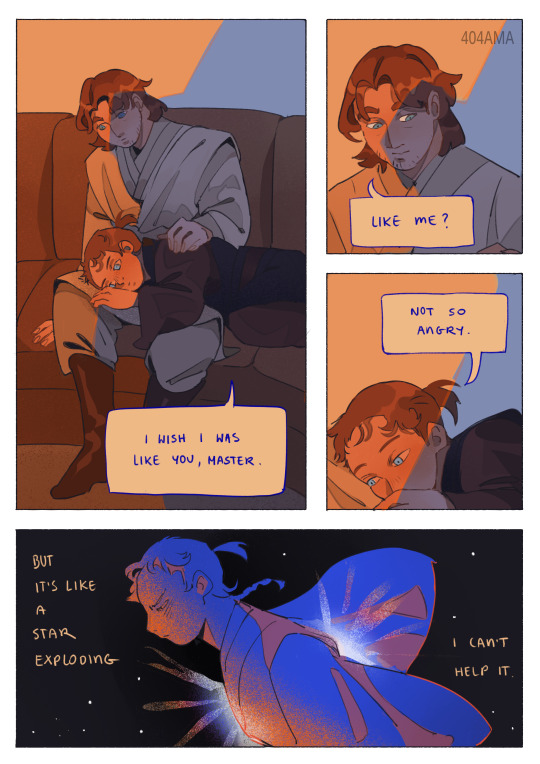
Anger issues.
✨🌙 ART LOG -> @404ama
Okokok, this is based on a dialogue from a fanfic I read a year or so ago but I cannot find the fanfic or the author anymore. (edit: we found the fic!!) I just remember this scene which i really liked and wanted to draw it :(
#star wars#star wars art#gffa#anakin skywalker#obi wan kenobi#sw fanart#sw prequels#jedi order#jedi#anakin#kenobi#sw comic#star wars fanart#art
6K notes
·
View notes
Text
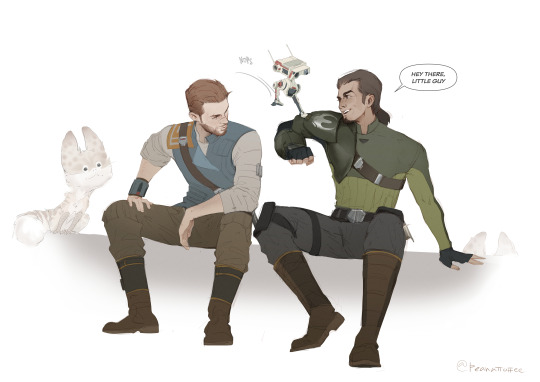
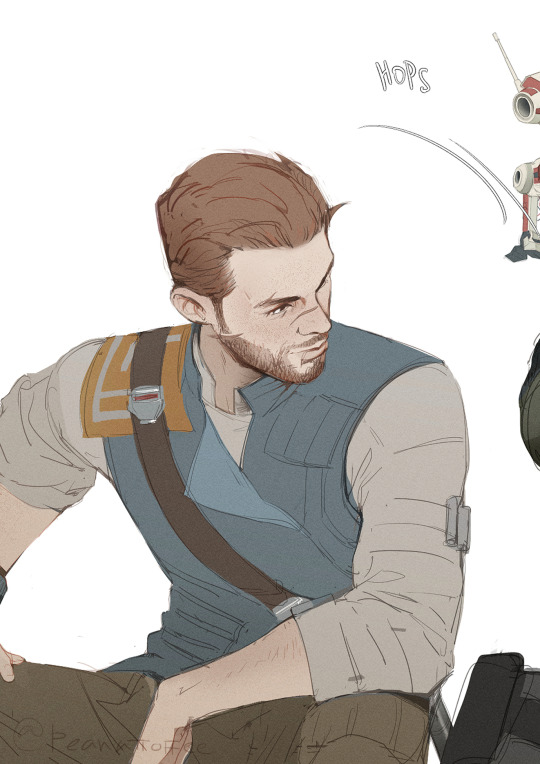

imagine if Cal and Kanan met after the Purge
i like the headcanon that they were bros back in padawan days, messing around and giving a headache to everyone in the temple c::
#honestly the only one Cal could’ve given a headache to is himself#with his psychometry talents#star wars#star wars fanart#cal kestis#kanan jarrus#caleb dume#bd 1#jedi survivor#jedi fallen order#star wars rebels#jedi order#jfo#sw rebels#rebels fanart#rebels au#my art#was in a sketching doodling mood suddenly#ah yes urgent assignments that you don't really want to do can do that to you#artists on tumblr
3K notes
·
View notes
Text
I think even funnier than Anakin being a Big War Hero is if he was like. The Temple’s resident tech guy. Cal or Kanan find out who Darth Vader is and they’re like ‘the guy who reset my password???’
#anakin expains Microsoft excel to the 80 year old masters#and introduces younglings to Cool Math Games#obi wan is known for killing Sith and anakin is known for turning the wifi off and on again#Anakin is mad bc obi wan DIDNT EVEN KILL THAT SITH#Ahsoka being like ‘oh I get to be the tech guy’s apprentice. yay 🙄’ and is genuinely surprised that the Sith-killer taught him how to fight#star wars#anakin skywalker#cal kestis#kanan jarrus#Jedi order#Darth Vader#jfo#jedi: fallen order#jedi: survivor#rebels#Star Wars rebels#caleb dume
1K notes
·
View notes
Text
"Luke Skywalker isn’t like the old Jedi. He saves Vader with his attachments!”
Wrong!
Luke Skywalker, at the end of Return of the Jedi, after his confrontation with the Emperor drags Darth Vader through the destructing Death Star. He’s desperate, knuckles white under the heavy weight of his father’s body, a little boy dragging his dad to safety. He sets Vader down for a moment, to catch his breath or maybe to get a better grip. He goes to grab Vader again, but Vader, uncomfortable and in pain, asks Luke to take off the mask. He wants to see Luke through his eyes instead of the eyes Palpatine built for him. Luke refuses, says that removing the mask is a sure way for Vader to die. Luke doesn’t want Vader dead, he wants Vader alive. Not to hold him accountable for his many evil acts, but for the same reason why Luke Skywalker can’t kill Darth Vader; Vader is his father and Luke loves him.
And yet, after a moment, Luke removes Vader’s mask. He doesn’t want to, he hesitates, but he removes the mask with enough slowness to allow Vader to take it back. In that moment, Luke sets aside his desire for Vader in his life, sets aside his desire to see him live, and sets aside his entire mission, the reason he was even on the Death Star in the place. In his compassion for his father, Luke stays with Vader until he dies. It is this moment where we see him be the best damn Jedi he can be. I’d even argue that this moment is the greatest example of non-attached love we see. Because Luke lets Vader go! He lets his father die, and in some ways, by removing the mask, he too kills Vader, he stays with him until his last moment, gives him the kindness of granting his last wish and finally chooses Vader.
And Luke doesn’t have to do this. If Luke Skywalker’s love for his father was an attachment, he would ignore Vader and continue dragging him to the escape pod, put his desire for a father as his central focus and ignore Vader’s wants and discomfort. Maybe he would even save him. But he doesn’t. Instead, he watches as Vader dies.
He builds a Jedi burial for his father and watches it burn the remnants of Vader and Anakin Skywalker away. He mourns Vader, he mourns what they could’ve had as father and son, considers what ifs and maybe-if-I-did-this. Vader/ Anakin is released from his mortal body, from his ‘crude matter’ and Luke lets him go. He says one final goodbye to Anakin. Then, he joins Leia, Han, Chewie, Lando, and the rest of the Rebels and celebrates their victory. He lives in the present and celebrates what he has instead of what he lost.
Luke Skywalker is THE Jedi. Everything about Luke Skywalker serves as the foundational cornerstone of the Jedi, everything about the Jedi as a culture and philosophy is reflected in his character. Luke’s desire for the New Jedi Order isn’t to throw away the values of the old Order, but to vitalise them, breathe life back into dying lungs, and rebuild a path that people set out on their way to destroy. (Yes, his Order is different from the Old, but that’s because it has to be. He doesn’t have the resources or the safety of the Old Order.) The philosophies of the Jedi are difficult and they aren’t for everyone, and like the perfect Jedi that Luke is, he struggles and stumbles and sometimes he even rejects it. But, no matter how far he falls, it is a way of life he chooses again and again and again. It is a way of life that welcomes him back each time
#luke skywalker#star wars#pro jedi#jedi positive#luke skywalker meta#luke skywalker loves being a jedi and i'm so tired of people pretending he doesn't#I hate you 'time-travel fics where Luke judges the Order for how they've handled things'#Luke would be the people's padawan actually chasing everyone down to acquire every bit of knowledge that they have#star wars meta#jedi order#the jedi#anakin skywalker#darth vader#the original trilogy#a new hope#empire strikes back#return of the jedi#if I tell you that luke outgrows anakin/vader? if I tell you that Vader is just the start of his Jedi growth and the end of it? then what?#Iong post#it kind of ran away from me
1K notes
·
View notes
Text
"the jedi don't have therapists-"
jedi philosophy, and in particular the practices and teachings that jedi were expected to implement in their everyday lives, was therapy. dialectical behavior therapy (dbt), to be exact. anyone who's familiar with dbt knows where i'm already going with this, but like genuinely look up the basic tenets of dbt and it's identical with what the jedi were doing.
dbt, to put it simply, is a specific therapy technique that was designed for ptsd and past trauma. it's pretty different from traditional talk therapy. it combines a few different environments (individual, group, etc.), recognizing that no single format of treatment can stand alone.
the key focuses of dbt include:
emotional regulation- understanding, being more aware of, and having more control over your emotions
mindfulness- regulating attention and avoiding anxious fixation on the past or future
interpersonal effectiveness- navigating interpersonal situations
distress tolerance- tolerating distress and crises without spiraling and catastrophizing
i'm sure it's already clear from that list alone how much the jedi teachings correspond with the goals of dbt. the jedi value, teach, and practice the following:
identifying and understanding emotions
mindfulness and living in the present
compassion, diplomacy, and conflict resolution (on interpersonal scales, not just planetary or galactic)
accepting and tolerating certain levels of distress or discomfort (particularly mental, such as discomfort at the thought of losing a loved one to death)
idk man seems almost as if jedi mental health practices and dbt are two sides of a completely identical coin. (fun fact: both star wars and dbt are products of the 70s.)
and guess what? dbt was specifically designed as a treatment for borderline personality disorder. remember that one? or, if you don't, maybe you remember a specific character, the one who was literally used as an example by my professor in my undergrad psych class when she was teaching us about bpd?

tldr: simply existing within the jedi community, practicing jedi teachings, surrounded by a support network of other jedi of all life stages, was the therapy for anakin. even when viewed through a modern lens. it was even, more specifically, the precise type of therapy that has developed in modern times to treat the exact types of mental issues he was struggling with.
#dbt#dbt therapy#dbt skills#dialectical behavior therapy#bpd#borderline personality disorder#anakin skywalker#anakin#star wars#sw#prequel trilogy#prequels#jedi#jedi culture#jedi philosophy#pro jedi#jedi appreciation#jedi order#attachment#non attachment#mindfulness#in defense of the jedi
3K notes
·
View notes
Text

Obi-Wan wants to introduce Anakin to someone, sadly Anakin doesn't know many manners.
#star wars#bons art#my art#obi wan kenobi#anakin skywalker#kid anakin#cal kestis#cal kestis is obi wan's son and i'll die on that hill#jedi survivor#jedi fallen order#jedi order#jedi#padawan anakin#Im 100% sure that anakin would terrorize Cal and be really jealous of a lactating baby
2K notes
·
View notes
Text


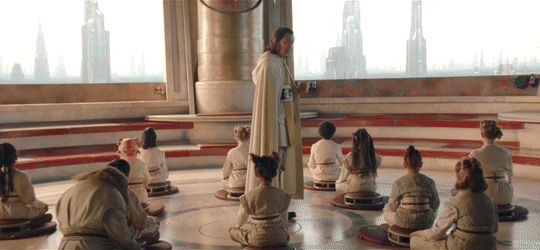
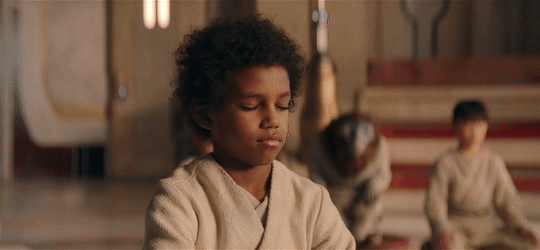
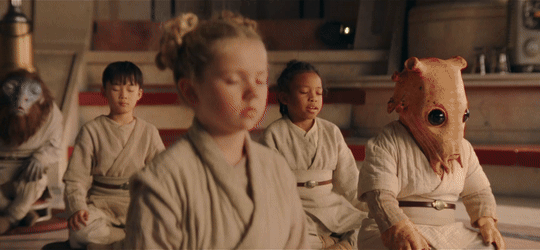
The Acolyte | Official Trailer | June 4th, 2024
#LOOK AT THE JEDI BABIES!!!!
#AND THE JEDI TEMPLE!!!
#AND LEE JUNG-JAE AS A JEDI MASTER!!!
#TEACHING THE JEDI BABIES IN THEIR ADORABLE LITTLE ROBES IN THEIR BEAUTIFUL TEMPLE!!!
#I AM NOT GOING TO SURVIVE HOW CUTE THESE BABIES ARE!!!!
2K notes
·
View notes
Text
One of the reasons why the Jedi Order is criticized is the fact that George Lucas' Star Wars actually shows that the good guys can't be always nice and you can't do perfect. The Clone Wars illustrates this masterfully: as Lucas said, "Are they going to stick with their moral rules and all be killed, which makes it irrelevant, or do they help save the Republic?" But some people are just unable to accept this.
There is always a right choice. Right doesn't mean it's the nicest and most perfect choice, the one that you might find the most satisfying and pure. But it's the best choice you can make in given circumstances. And in 99% of life, that's all we can do.
1K notes
·
View notes
Text
The Star Wars fandom is like a case study of what happens when you overthink media intended for children to the point that you’ve completely altered the message and plot that the creator intended. The whole “the Jedi order is evil and Anakin/Vader is the good guy!” Idea fails to take into account the fact that like.. these movies are meant for kids, they’re meant to be easy to follow and easy to understand with obvious good guys and obvious bad guys. Yknow how we know the Jedi are the good guys? - they’re the main characters, they have funny one liners, they kill the evil bad guys who have red laser swords with their blue and green laser swords, they’re relatable, they’re nice, they’re paternal, so on so forth.
I love critical analysis and I’d never speak a word against it, when we consume media we should always take a step back to consider what ideas they’re selling us, what undertones are portrayed, is this supposed to represent a real life problem? But it’s also equally as important to consider who the audience is and how that might impact the story. And ultimately the audience is children, Star Wars is not meant to be a mystery thriller where the good guys are secretly the bad guys which you can only tell when you pick the story apart 20 which ways. The movies could not more clearly tell us who were meant to support. - is it the angry guys with red swords, ugly old guy who shoot’s lighting out of his fingers and takes over the universe, people who blow up planets, chop off their kids hands and blow up planet’s? Or is it the people who wear warm coloured clothing, talk about wanting peace, who tell funny jokes, have heartfelt moments, with blue and green lightsabers, fight against the space fascists and love each other.
Ultimately, Star Wars isn’t that deep, enjoy it for what it is and I promise you’ll enjoy it 100 times more
#pro jedi order#pro jedi#star wars#the rebellion#the empire star wars#jedi order#the best skill you’ll ever learn is to just enjoy things I promise
1K notes
·
View notes
Text
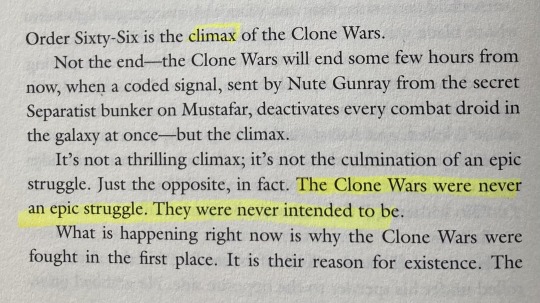

to me this is one of the most important passages of the revenge of the sith novelization, as it contains a fundamental thesis of the prequels. the clone wars were designed to kill jedi. sidious put the order in checkmate before they'd even begun fighting. he used their compassion and trust against them by leveraging their sense of duty to push them into fighting a morally dubious war to protect innocent lives, tarnishing their galactic reputation. he gave them friends in the clones that were crafted to become their assassins. he spread the jedi out, thinned their numbers in years of brutal combat, and then when they were sufficiently weak, wiped them out.
the revenge of the sith required so much planning and moving from the shadows over decades to arrange the galaxy into a trap. the prequel jedi did not have the knowledge that we the audience have, they were operating out of a place of partial understanding and with the best of intentions. to hold them to a standard of omniscience and omnipotence instead of appreciating the genius and patience of the sith is unfair and missing the point. they're not perfect, but they are good. it is tragic that being good is not always enough, it is tragic to know that our best of intentions can come up short. it is tragic that evil can gain power and harm the innocent without repercussions.
this book is heartbreaking on a personal level, but also on a political and ideological one. it reflects the very real world when greed and fear hold sway over a population, where exploitation and oppression win. the jedi are slain and it is brutal to read, and a generation afterward struggling in the dark without them. however, star wars ultimately carries a message of hope: you can kill jedi, but you cannot kill compassion and community. wherever people love each other, there is light. the empire fell and the jedi returned because you cannot kill their ideas. so there is hope, but that doesn't change that it is an egregious crime in the prequels that they were slaughtered.
#star wars#revenge of the sith my beloved#jedi order#sw#sorry this is wordy and long but i just have a lot of feelings about this goddamn book
2K notes
·
View notes
Photo
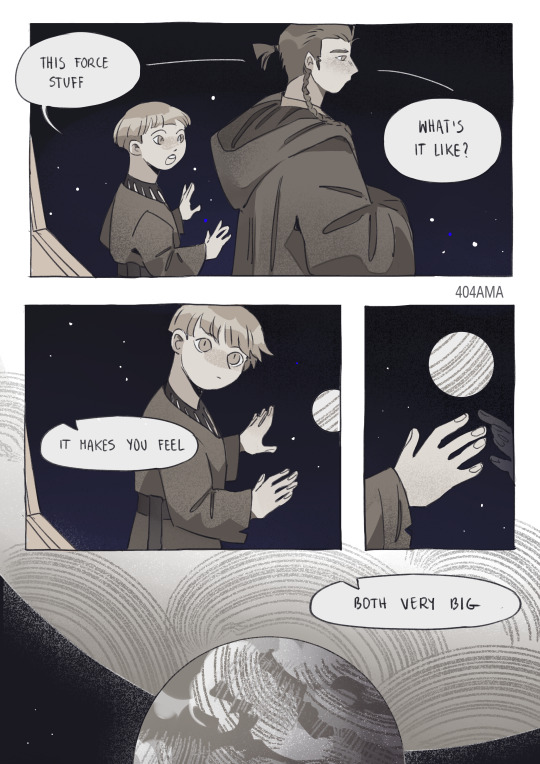
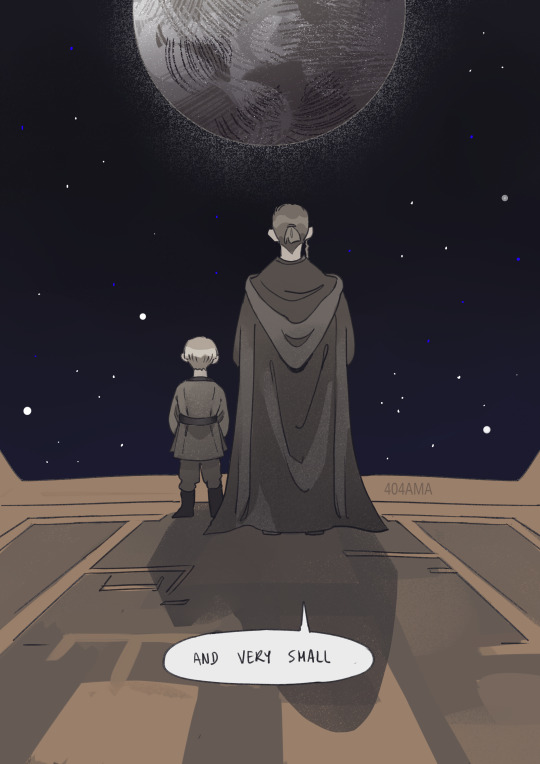



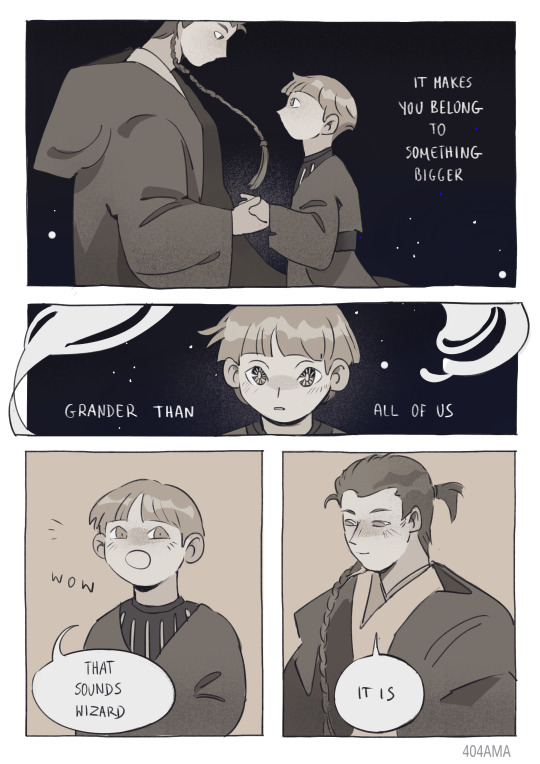
@jedijune 02 The Force
✨🌙 ART LOG -> @404ama
#star wars#obi wan kenobi#star wars prequels#gffa#jedi june#jedi order#star wars fanart#sw comic#anakin skywalker#sw art#phantom menace#anakin#jedi#sw prequels#art
18K notes
·
View notes
Text
A reminder that Bail Organa, upon seeing the Jedi Temple in flames, immediately flew straight over to investigate himself with no guards and no weapons of his own. And upon being told there was a rebellion by the clone troopers there, he attempted to walk past them and see what was happening himself.
It was only after they aimed blasters at him that Bail leaves with a newfound resolve to stop Palpatine. He didn't wait until Palpatine declared himself Emperor to know he had to do something. He knew he was bad right there.
#Bail Organa#Bail Organa appreciation#Star Wars#Star Wars prequels#Pro Jedi#Jedi Order#pro Jedi Order#pro Bail Organa#Order 66
2K notes
·
View notes